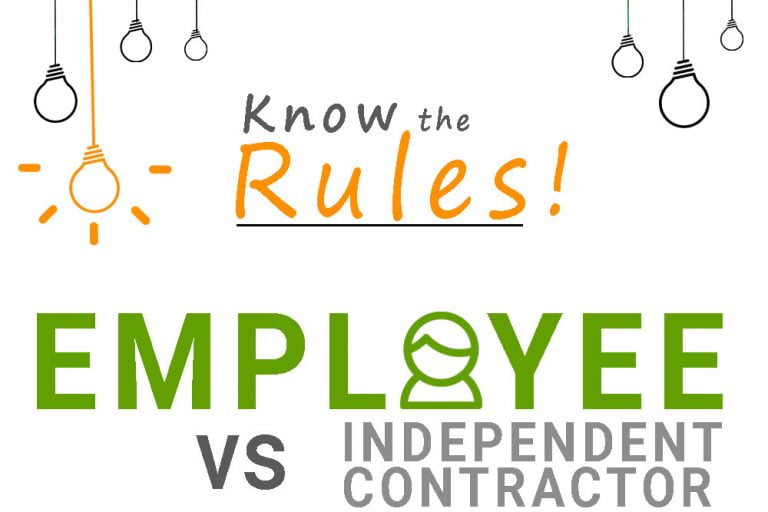What employers need to know on how to classify workers as employees or independent contractors
It is critical for business owners to determine whether the individuals providing services are employees or independent contractors.
More companies in recent decades have been classifying their workers as independent contractors as opposed to full-time or part-time employees to save on salaries and benefits, and that trend has only accelerated in recent years with the advancement of technology and the ability of service providers to work remotely from anywhere in the world. In this brave new world, employers may struggle with how to define their workforce.
Current labor laws recognize workers providing services can be categorized as either an independent contractor or an employee. Employees are generally protected by more employment rights. On one hand, classifying service providers as independent contractors can be more efficient and cost-effective for a company. On the other hand, misclassifying service providers can have dire consequences, leaving a company exposed to expensive class actions for wage, hour, and other Labor Code violations— not to mention staggering governmental fines and penalties.
An employee is generally considered anyone who performs services, if the business can control what will be done and how it will be done. What matters is that the business has the right to control the details of how the worker’s services are performed. Independent contractors are normally people in an independent trade, business or profession in which they offer their services to the public. Doctors, dentists, veterinarians, lawyers, accountants, contractors, subcontractors, public stenographers or auctioneers are generally independent contractors.
Whether a worker is an independent contractor, or an employee depends on the relationship between the workers and the business. There are three categories to consider:
The first category—“Behavioral”— refers to facts showing whether a company has a right to direct or control how the worker does the work. A worker is an employee when the business has the right to direct and control the worker. Within this category, the IRS examines four subcategories:
1. Type of instructions given. An employee is generally subject to the business’s instructions about when, where, and how to work.
2. Degree of instruction. More detailed instructions indicate that the worker is an employee.
3. Evaluation systems. If an evaluation system measures the details of how the work is performed, then these factors would point to an employee.
4. Training. If the business provides the worker with training on how to do the job, this is strong evidence the worker is an employee.
The second category—Financial—refers to facts that show whether the business has the right to control the economic aspects of the worker’s job. Within this category, the IRS examines five subcategories:
1. Significant investment. An independent contractor often has significant investment in equipment used in working for someone else.
2. Unreimbursed expenses. Independent contractors are more likely to have unreimbursed expenses than are employees.
3. Opportunity for profit or loss. Having the possibility of incurring a loss indicates that the worker is an independent contractor.
4. Services available to the market. An independent contractor is generally free to seek out business opportunities.
5. Method of payment. An employee is generally guaranteed a regular wage amount for an hourly, weekly, or other period of time, while an independent contractor is usually paid by a flat fee for the job.
The third category—Relationship—refers to facts showing how the worker and business perceive their relationship to each other. Within this category, the IRS examines four subcategories:
1. Written contracts. A contract stating that the worker is an employee or an independent contractor is helpful but not determinative of worker status.
2. Employee benefits. Businesses generally do not grant benefits such as insurance, pension plans, paid vacation, sick days, and disability insurance to independent contractors.
3. Permanency of the relationship. If a worker is hired with the expectation that the relationship will continue indefinitely, rather than for a specific project or period, this is generally considered evidence that the intent was to create an employer-employee relationship.
4. Services provided as key activity of the business. If a worker provides services that are a key aspect of the business, it is more likely that the business will have the right to direct and control his or her activities.
Misclassification of Employees
A service provider mischaracterized as an independent contractor can bring wage, hour, and other violations under the various federal and state employment statutes.
Further, classifying an employee as an independent contractor with no reasonable basis for doing so makes employers liable for employment taxes. This applies to Federal as well as State and local employment taxes.
Misclassification audits, investigations, and lawsuits are increasingly common and can result in steep costs and penalties. An employer who misclassifies may be on the hook for back payment of employee taxes, unpaid unemployment and disability insurance, unpaid worker’s compensation coverage, and even large fines and penalties.
Advice for Employers
There are a number of steps that employers can take to minimize the risk of misclassifying service providers and to show that their classification was reasonable and made in good faith. These steps include:
- DO have an independent contractor agreement with the contractor, which must describe the scope of the work to be performed, the compensation paid, and the timing of the work, and clearly define the contractor’s tax obligations.
- DON’T have the contractor complete an employee application.
- DO ensure that the contractor has liability insurance, particularly if the contractor is a professional.
- DO ensure that any professional contractor has a current professional license from the city/county in which he/she is operating.
- DON’T set the contractor’s work hours.
- DON’T provide the contractor with tools, equipment, software or supplies with which to perform his/her work.
- DON’T provide the contractor any benefits that the business provides to its employees.
- DON’T retain or terminate or attempt to retain or terminate assistants or employees for the contractor.
- DO ensure that the contractor submits invoices for his/her work.
- DO require payment to be rendered upon completion of a certain task or job. Do not pay by the hour, week or month unless a flat fee is agreed to be paid at regular intervals.
- DO not pay contractor expenses. Businesses pay their own expenses, and expenses should be built into the contract for the cost of the entire job. The opportunity for profit or loss by the contractor helps to show financial independence from the employer.
- DO require the contractor to complete Form W-9, Request for Taxpayer
- Identification Number and Certification.
- DON’T complete an I-9.
- DON’T provide an employee handbook.
- DON’T conduct performance evaluations similar to employee evaluations.





